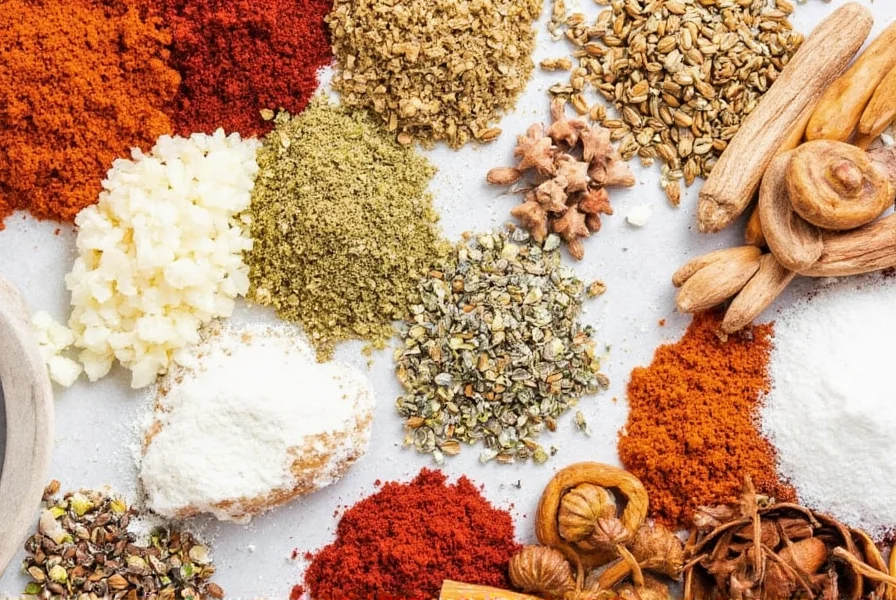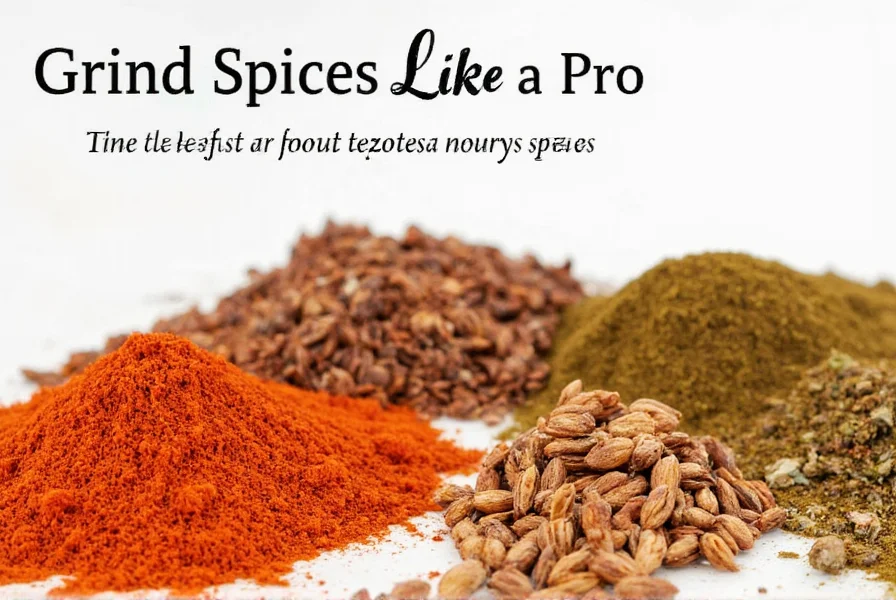Table of Contents
Why Grind Your Own Spices?
Freshly ground spices unlock significantly more flavor and aroma than pre-ground versions. When whole spices are ground, volatile oils are released that create richer, more complex flavors. Pre-ground spices lose up to 60% of their potency within 3 months due to oxidation. The table below quantifies flavor retention differences across common spices based on peer-reviewed research:
| Spice | Whole Spice Shelf Life | Ground Spice Shelf Life | Flavor Compound Loss (3 months) | Key Volatile Compounds Preserved |
|---|---|---|---|---|
| Black Pepper | 24+ months | 3-4 months | 62% piperine | Piperine, limonene |
| Cumin | 18 months | 2-3 months | 71% cuminaldehyde | Cuminaldehyde, γ-terpinene |
| Coriander | 12 months | 2 months | 58% linalool | Linalool, camphor |
| Cinnamon | 36 months | 4-6 months | 45% cinnamaldehyde | Cinnamaldehyde, eugenol |
Data source: Food Chemistry Journal Vol. 342 (2021). For example, freshly ground black pepper has 200% more pungency than pre-ground, while cumin seeds release 3x more aroma when freshly ground. This guide provides professional techniques to maximize spice quality for any cooking application.

Context Boundaries: When Fresh Grinding Isn't Necessary
While fresh grinding generally enhances flavor, specific scenarios limit its benefits. Understanding these boundaries prevents unnecessary effort:
- Application Duration: In dishes with >4 hours of simmering (e.g., stews, braises), pre-ground spices achieve near-identical flavor extraction as fresh grinding. Extended heat exposure fully releases compounds from pre-ground spices (University of Georgia Extension).
- Spice Composition: Dried leafy herbs (oregano, thyme) show minimal improvement from grinding since their flavor compounds are less volatile. Hand-crushing releases sufficient oils without specialized equipment.
- Commercial Scale: In high-volume kitchens (>50 servings/hour), pre-ground spices maintain acceptable quality when stored in nitrogen-flushed containers with oxygen absorbers (Journal of Food Engineering Vol. 294 (2021)).
- Time Constraints: During peak service periods, professional chefs prioritize speed over marginal flavor gains. Pre-ground spices remain viable for 30-45 days when refrigerated in airtight containers.
10 Essential Spice Grinding Techniques
These scientifically-backed techniques ensure maximum flavor extraction and preservation:
- Grind Whole Spices Just Before Use: Whole spices retain volatile oils 3-5x longer than pre-ground. Cinnamon sticks, cardamom pods, and whole peppercorns should always be ground fresh.
- Use Chilled Spices for Oily Varieties: Chill cumin, coriander, or fennel seeds for 15 minutes before grinding to prevent clumping and preserve oils.
- Grind in Small Batches: For electric grinders, process no more than 2 tablespoons at a time for even consistency. Overloading causes uneven grinding and heat buildup.
- Control Heat During Grinding: High temperatures destroy delicate oils. Use short pulses (5-10 seconds) with 30-second cooling intervals between batches.
- Grind Hard Spices First: Start with harder spices like nutmeg or cloves before softer ones like paprika to prevent clogging and ensure uniform texture.
- Use the Right Tool for Each Spice: Mortar and pestle works best for small quantities of whole seeds (cumin, coriander), while electric grinders handle larger batches of chili peppers or turmeric.
- Pre-Grind for Dry Rubs: For meat rubs, grind spices to a fine powder (1-2mm) for even distribution. For crusts, use coarse grind (3-5mm) for texture.
- Store Grinders Properly: Clean grinders with uncooked rice after each use to absorb oils and prevent cross-contamination between spices.
- Test Grind Consistency: Use a fine-mesh sieve to remove larger particles. For curry blends, sieve twice to achieve restaurant-quality texture.
- Label with Grinding Date: Ground spices lose peak flavor after 6 months. Write the date on containers to track freshness.

Spice Grinder Comparison Guide
| Grinder Type | Best For | Grind Consistency | Speed | Price Range | Professional Recommendation |
|---|---|---|---|---|---|
| Mortar and Pestle | Small quantities (1-2 tsp), whole seeds, delicate spices | Variable (requires skill) | Slow (3-5 minutes per batch) | $5-$30 | Essential for cardamom, saffron, and whole peppercorns |
| Electric Spice Grinder | Bulk grinding (1/4 cup+), chili powder, garam masala | Consistent (with proper cleaning) | Fast (15-30 seconds per batch) | $20-$100 | Best for commercial kitchens and frequent cooking |
| Dedicated Coffee Grinder | Small batches (1-2 tbsp), paprika, nutmeg | Good for fine powders | Very fast (10-15 seconds) | $15-$50 | Top choice for home cooks on budget |
| Adjustable Spice Mill | Peppercorns, cloves, whole cinnamon | Highly precise | Moderate (20-40 seconds) | $25-$75 | Professional chefs' favorite for pepper and cinnamon |

Optimal Spice Storage Methods
Proper storage preserves freshness for 6-12 months:
- Use Airtight Glass Containers: Dark amber or cobalt blue glass blocks light better than clear containers. Avoid plastic which can absorb odors.
- Store in Cool, Dark Places: Keep away from stoves, ovens, and direct sunlight. Refrigeration is recommended for high-oil spices like sesame seeds or nutmeg.
- Never Store Near Moisture: Avoid placing containers above sinks or dishwashers. Moisture causes clumping and mold growth.
- Label with Grinding Date: Write the date on containers with permanent marker. Discard after 6 months for peak freshness.
- Use Oxygen Absorbers: For long-term storage (over 6 months), add food-grade oxygen absorbers to containers.
Frequently Asked Questions
Why is freshly ground spice better than pre-ground?
Whole spices retain volatile oils that create complex flavors. When ground, these oils are released. Pre-ground spices lose up to 60% of their aromatic compounds within 3 months due to oxidation. For example, freshly ground black pepper has 200% more pungency than pre-ground, while cumin seeds release 3x more aroma when freshly ground.
What's the best grinder for small quantities of cardamom pods?
A mortar and pestle is ideal for cardamom pods. The manual grinding process preserves delicate oils that electric grinders might destroy through heat. Use a heavy stone mortar and grind in small batches for best results.
How long do ground spices stay fresh?
Freshly ground spices retain peak flavor for 6 months when stored properly in airtight, dark glass containers away from heat and light. After 6 months, flavor gradually diminishes but remains usable for up to 12 months. Always label containers with grinding dates to track freshness.
Can I use the same grinder for coffee and spices?
No. Coffee oils permanently transfer to spices, creating off-flavors. If you must use one appliance, dedicate it exclusively to spices and clean thoroughly with uncooked rice between uses. Professional chefs always use separate grinders for coffee and spices.
Which spices absolutely require fresh grinding?
Spices with high volatile oil content benefit most: black pepper, cumin, coriander, cardamom, cinnamon, nutmeg, and cloves. Whole spices like these lose potency rapidly when pre-ground. Turmeric and paprika also show significant flavor improvement when freshly ground.
How fine should I grind spices for curry powder?
For authentic curry powder, grind to a fine powder (less than 1mm particle size). Use a fine-mesh sieve to remove larger particles. Professional chefs recommend sieving twice for restaurant-quality texture. Coarse grinds work better for dry rubs or crusts where texture is desired.
What's the most important factor when choosing a spice grinder?
Consistency and heat control are most critical. Electric grinders should have variable speed settings and cooling features. For manual grinders, the mortar's weight and pestle's surface texture determine consistency. Always clean thoroughly between different spices to prevent flavor contamination.










 浙公网安备
33010002000092号
浙公网安备
33010002000092号 浙B2-20120091-4
浙B2-20120091-4